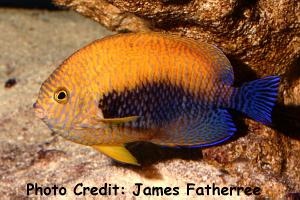
By Bob Goemans

Likely Reef Tank Suitable
Likely Fish-Only Tank Suitable
Range: Eastern Central Pacific Ocean: Hawaii and Johnston Atoll
Size: 4 inches (10 cm)
Natural Environment: Inhabits coastal reef faces, under ledges and fore-reef areas at depths of 10 to 450 feet (3 – 138 m). Its diet in the wild consists of filamentous and diatom algae, sponge, and detritus. Males form small social groups containing up to 8 females.
General Husbandry: This very pretty species dwarf angelfish accepts a wide variety of foods including fortified brine shrimp, mysis, and flake food (especially Spirulina). Requires numerous small feedings per day, as it’s a constant browser. Keep in mind this is often a somewhat secretive species, and in large aquariums with much live rock and hiding places, may seldom be seen. Nevertheless, they do require hiding places, even in small aquariums, as they like to glide in and out of rock crevices while forging for foodstuffs. It’s recommended this species be the last fish to be added, as they can be aggressive toward following additions and may also annoy some damselfishes and tangs. Also, it‘s preferable to add this species to a 'well-established' reef aquarium, as it likes to pick on rocks containing various forms of algae or find accumulations of detritus to ingest.
Not suited for small nano style aquariums, as they become quite aggressive in these small aquariums and cannot without numerous feedings per day find enough food to be maintained long-term.
This is a very pretty species, as the front half of the Potter’s Angelfish is a bright vibrant orange which fades into a deep purple in its back half. Deep purple vertical stripes are present over its entire body. There are no differences in coloration between males and females. The Potter’s Angel is really an amazing addition to almost any tank.
Taxonomy:
Order: Perciformes
Suborder: Percoidei
Family: Pomacanthidae
Genus: Centropyge
FYI: All Centropyge species start life as unsexed individuals, but begin their adult life as females. Then, the larger or more dominant individual within small groups will change sex within a few days to a couple of weeks and become a male. Knowing that size is the main difference between the sexes, and not so much its coloration, all one needs to do is place a small and larger specimen together. Within approximately sixty days either one of the two fish will have physically changed sex to accommodate the other. A reversal of this sex change is possible if the need arises, but that requires much more time, e.g., weeks to months.
Keep in mind all angels have cheekspines at the edge of their gill cover; therefore use caution when handling and also avoid using a net to capture it, as it may become stuck or tangled in the net and become damaged when removed.
Experience Level: Intermediate
Temperament: Semi-aggressive
Diet: Omnivore
Acclimation Time: 30 minutes+
Aquarium Environment: Reef aquarium (see below) or fish-only aquarium
Reef Safe: With caution, as some specimens have a tendency to nip clam mantles, large–polyped stony corals and some soft corals.
Minimum Tank Size: 75 gallons
Temperature Range: 68 - 82°F (20 – 27°C).
Specific Gravity: 1.020-1.027
pH: 8.0 - 8.5
